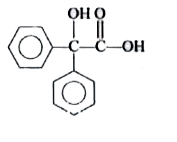an Organic compound (A)(C4H6) forms a precipitate with Tollens and Fehling's reagents. (A) has an isomer (B). (B) reacts with 1mol of Br2 to form 1,4-dibromo-2-butene. (A) and (B) are:
a.
b.
c.
d.
The correct Answer is:A
To solve the problem, we need to identify the organic compounds (A) and (B) based on the given information. Let's break down the solution step by step.
Step 1: Determine the Degree of Unsaturation
The molecular formula of compound (A) is C₄H₆. We can calculate the degree of unsaturation (DU) using the formula:
Degree of Unsaturation=2C+2−H2
Where C is the number of carbon atoms and H is the number of hydrogen atoms.
Substituting the values:
DU=2(4)+2−62=8+2−62=42=2
Step 2: Analyze the Degree of Unsaturation
A degree of unsaturation of 2 indicates that the compound could have either:
- One triple bond (alkyne) or
- Two double bonds (alkenes).
Step 3: Identify Compound (A)
Since compound (A) forms a precipitate with Tollens' and Fehling's reagents, it suggests that (A) is likely a terminal alkyne. Terminal alkynes can reduce these reagents.
A suitable structure for compound (A) is 1-butyne (or methylacetylene), represented as:
CH3C≡CH
Step 4: Confirm the Reaction with Tollens' and Fehling's Reagents
When 1-butyne reacts with Tollens' reagent (ammonical silver nitrate), it forms a white precipitate of silver butylenide (AgC≡C-CH₃). Similarly, it will react with Fehling's solution to produce a red precipitate of copper(I) oxide.
Step 5: Identify Compound (B)
Compound (B) is an isomer of (A) and has the same molecular formula (C₄H₆). It reacts with 1 mole of Br₂ to form 1,4-dibromo-2-butene.
The structure of compound (B) can be deduced as follows:
CCCC
with two double bonds, specifically 1,3-butadiene:
CH2=CH−CH=CH2
Step 6: Confirm the Reaction with Bromine
When 1,3-butadiene reacts with bromine (Br₂), it can add across the double bonds to yield 1,4-dibromo-2-butene:
Br−CH2−C=C−Br−CH2
Conclusion
Thus, the compounds are:
- Compound (A): 1-butyne (C₄H₆)
- Compound (B): 1,3-butadiene (C₄H₆)
The molecular formula of compound (A) is C₄H₆. We can calculate the degree of unsaturation (DU) using the formula:
A degree of unsaturation of 2 indicates that the compound could have either:
- One triple bond (alkyne) or
- Two double bonds (alkenes).
Since compound (A) forms a precipitate with Tollens' and Fehling's reagents, it suggests that (A) is likely a terminal alkyne. Terminal alkynes can reduce these reagents.
When 1-butyne reacts with Tollens' reagent (ammonical silver nitrate), it forms a white precipitate of silver butylenide (AgC≡C-CH₃). Similarly, it will react with Fehling's solution to produce a red precipitate of copper(I) oxide.
Compound (B) is an isomer of (A) and has the same molecular formula (C₄H₆). It reacts with 1 mole of Br₂ to form 1,4-dibromo-2-butene.
with two double bonds, specifically 1,3-butadiene:
When 1,3-butadiene reacts with bromine (Br₂), it can add across the double bonds to yield 1,4-dibromo-2-butene:
Thus, the compounds are:
- Compound (A): 1-butyne (C₄H₆)
- Compound (B): 1,3-butadiene (C₄H₆)
Topper's Solved these Questions
- REDUCTION AND OXIDATION REACTION OF ORGANIC COMPOUNDSBOOK - CENGAGE CHEMISTRY ENGLISHCHAPTER - REDUCTION AND OXIDATION REACTION OF ORGANIC COMPOUNDSEXERCISE - Exercise (Assertion And Reasoning)
10 Videos
- REDUCTION AND OXIDATION REACTION OF ORGANIC COMPOUNDSBOOK - CENGAGE CHEMISTRY ENGLISHCHAPTER - REDUCTION AND OXIDATION REACTION OF ORGANIC COMPOUNDSEXERCISE - Exercise Archives (Subjective)
26 Videos
- REDUCTION AND OXIDATION REACTION OF ORGANIC COMPOUNDSBOOK - CENGAGE CHEMISTRY ENGLISHCHAPTER - REDUCTION AND OXIDATION REACTION OF ORGANIC COMPOUNDSEXERCISE - Exercise (Multiple Correct)
35 Videos
- QUALITATIVE INORGANIC SALT ANALYSISBOOK - CENGAGE CHEMISTRY ENGLISHCHAPTER - QUALITATIVE INORGANIC SALT ANALYSISEXERCISE - Viva Voce Questions And Part-C (Analysis Of Cations)
42 Videos
- SOLID STATEBOOK - CENGAGE CHEMISTRY ENGLISHCHAPTER - SOLID STATEEXERCISE - Ex 1.2 (Objective)
9 Videos
Similar Questions
Knowledge Check
An organic compound (A), C7H6O gives positive test with Tollen's reagent, on treatment with alcoholic CϴN,(A) yields the compound (B),C14H12O2. Compound (B) on reduction with Zn-Hg, HCl and dehydration gives an unsaturated compound (C), which adds on mole of Br2/CCl4. The compound (B) can oxidized with HNO3 to a compound (D), C14H10O2. Compound (D) on heating with KOH undergoes rearrangement adn subsequent acidification of rearranged products yields an acidic compound (E), C14H12O3.
Structure of compound (B) isA B
B C
C D
D
Unknown compound (A) C5H10O give positive test with 2,4 - DNP
but negative test with Tollen's reagent. It also give yellow precipitate with I2/NaOH . (A) is :A B
B C
C D
D
Compound A(C3H5N) gives precipitate with Tollen's reagent and H2 gas is also evolved on addition of Li metal. Compound A can be :
View SolutionB2H6 reacts with O2 and H2O respectively to form
View SolutionB2H6 reacts with O2 and H2O respectively to form?
View SolutionPhenol reacts with methyl chloroformate in the presence of NaOH to form product A. A reacts with Br2 to form product B. A and B are respectively
View SolutionAn organic compound has the formula C4H10O. It reacts with metallic sodium liberating hydrogen.
What will be the product formed if it reacts with an organic acid ?
View SolutionAn organic compound has the formula C4H10O. It reacts with metallic sodium liberating hydrogen.
What will be the product formed if it reacts with an organic acid ?
View Solution
